Ossett - the history of a Yorkshire town
- ossett :
- Home :
- What's New :
- Picture Gallery :
- WW1 Remembrance :
- WW2 Remembrance :
- Contact :
Gawthorpe
Gawthorpe is a small village on the northern outskirts of Ossett with historic ties to Dewsbury and the settlement of Kirkhamgate (via the Gawthorpe Lane footpath) in Wakefield. For many years, Gawthorpe was considered a separate hamlet, but in 1866, it was joined with Ossett and South Ossett to become Ossett-cum-Gawthorpe.

Above: Picture of High Street, Gawthorpe circa 1911, showing the now defunct High Street stores (later Gawthorpe Post Office) and to the right of the shop is the Boot and Shoe public house. Immediately to the left of the building housing the shop is the Gawthorpe Zion Chapel.
The use of ‘thorpe’ (originally pronounced ‘throp’) in place names is of Danish origin, and means ‘outlying farmstead’. The earliest spelling of the Yorkshire village is Gaukethorp, which means, ‘the farmstead of Gauke’, with Gauke being the name of the settlement's founder who almost certainly was a Viking. However, there is evidence to suggest the village may have existed in Roman times and certainly there was a small Roman settlement at nearby Street Side, alongside the old Roman road.
Like most English villages, Gawthorpe used to be self-contained with a large selection of shops offering every conceivable type of goods and service. There were greengrocers, confectioners, butchers, blacksmiths, shoemakers, bakers, barbers and ale sellers who all plied their trade at the end of the 19th century. In 1891, Benjamin Day, aged 73 and his 20 year-old grandson Halliday Day had a greengrocer's shop on High Street, near Tately Lane, but were also herb beer brewers, producing non-alcoholic drinks for those customers who were perhaps members of the Temperance Movement.
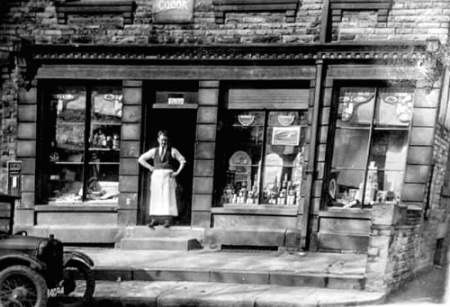
Above: Gawthorpe Post Office 1930s.
The villagers didn't have much in the way of transport, so local shops competed on price and quality alone. There was still a good selection of shops in the village during the 1960s and 1970s, with a busy Co-op store, a post office and general store. Today there are none. It is as if the heart has been taken out of the village, largely caused by the modern trend to shop in out-of-town supermarkets. Much of the community spirit in the village has disappeared with the closure of all the local shops.
The construction of the Ossett bypass, which snakes obscenely through the very southern edge of the village has destroyed some of the ancient charm of Gawthorpe. Fine old buildings such as Royds Villas and The Mount were demolished to make way for the asphalt and speed cameras.

Above: Houses on Swithenbank Street, Gawthorpe pictured in 1972, perched precariously at the side of the excavations for the new Ossett bypass.
 The Maypole
The Maypole
Gawthorpe is one of the few places where a permanent Maypole may still be seen. Indeed the Maypole and its cul-de-sac setting are two characteristics by which Gawthorpe is remembered by visitors. The only other village nearby that still has a Maypole celebration is Barwick-in-Elmet, to the north-east of Leeds.
The continued presence of a Maypole in Gawthorpe has not been easy since its existence has been endangered from time-to-time. The fact that a Maypole is still standing is due largely to local pride, determination and tenacity of purpose. When, precisely, a permanent Maypole was first erected in Gawthorpe is not easy to say. There was certainly one standing in the present site in 1840. In 1850, a Gawthorpe resident by the name of Mr. A. Pollard, suggested and bought, the first recorded permanent Maypole for the village. Previously, each year, a birch tree from local woods had been cut down and used as a Maypole.
The new Maypole, complete with weathercock on top was duly erected. At this time the 'Streetsiders' i.e. people living in the vicinity of the Waggon and Horses public house helped in the organising of the May Celebrations and they were represented on the Maypole Committee. A problem dealt with by the Committee led to a dispute between the Gawthorpe and Streetside elements in the Committee. The 'Streetsiders' were in a minority and were outvoted. This made them resort to other methods and so, one night, a party of 'Streetsiders' sawed down the Maypole and carried it away, placing it in the yard behind the Wagon and Horses. That Maypole never came back to Gawthorpe.
Shortly after taking the Maypole, and it is believed, with the motive of adding insult to injury, the 'Streetsiders' made another nocturnal expedition with the object of digging out and taking away the stump of the pole that they had previously sawed down. However, they were met with sterner opposition this time and a pitched battle ensued in which, it is said, one man was killed, one crippled for life and several others had scars as mementoes. It was only terminated when the wives and other women folk intervened.
The next pole was erected by public subscription and voluntary labour in 1874 and in 1875, the first procession took place. There was a free tea and the "Ossett Observer" for May 8th, 1875 said this:
"A public notice invited the ratepayers of Ossett and Gawthorpe to partake of a free tea at the old schoolroom to commemorate the raising of the Maypole. Precedence to be given to ladies over 50 years of age. On putting in an appearance, we were cordially welcomed by two of the Committee at the door, who were distinguished by wearing satin rosettes. Entering, we partook of a capital cup of bohea (a black Chinese tea); there was a full attendance and huge piles of tea cake and other comestibles provided, which were partaken of by about two hundred persons at different sittings down. After tea, the procession arrived from Ossett headed by seven of the Committee on horseback and the South Ossett Band, numbered by about 24 performers. The Band, stationed near the Maypole discoursed some excellent music, which caused the horses to prance around the pole as though they were dancing, which bipeds were prevented from doing by reason of the weather. The proceedings closed by the singing of the Doxology (a short hymn as Christian praise to God). The Committee partook of a substantial knife and fork tea at Mr. B. Cooper's 'The Old Shoulder of Mutton Inn'."
Again, in 1880, the 'Streetsiders' made another attempt to saw down the Maypole. This was again attempted during the night. However, when the pole was partially sawn through, the intruders were disturbed and had to run. Though they did not get the Maypole this time, the 'Streetsiders' saw nevertheless proved effective, because the pole was so weakened that it was blown down in a gale, which occurred a few nights later.
The next Maypole was erected without delay, this time with iron plates covering the bottom portion of the pole to protect the Maypole from further damage from the 'Streetsiders' saw. At a later date, the iron plates were removed and a fence with spiked iron railings was erected around the foot of the post to serve the same purpose as the iron plates and not merely to keep off children.
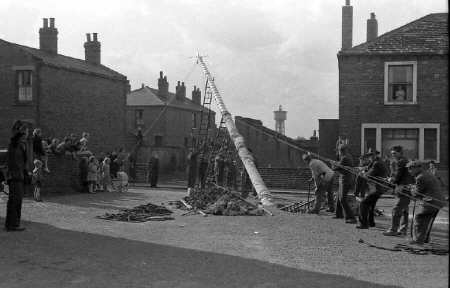
Above: Erecting the Maypole in 1953 the hard way, using ropes and muscle power. This Maypole lasted until 1986 when it was found to be rotten and had to be replaced for safety reasons.
Traditionally, the Maypole festivities on the first weekend in May include a procession through the streets of Gawthorpe and Ossett, with the reigning May Queen leading the parade on horseback, followed closely by her six attendants. The procession includes decorated floats entered by local schools, church organisations and local businesses. There are also children in fancy dress, marching bands and a large contingent of horses and riders. The mayors of Wakefield and Kirklees are also invited to take part along with the local M.P. and other dignitaries. Other features of the day are the Maypole plaiters, who are all pupils from Gawthorpe Junior and Infants School and a funfair with various rides and stalls. On the Monday immediately following the Maypole procession, a sit-down tea and entertainment is provided for Gawthorpe's old folk.

Above: A team of volunteers led by Mr. C.C. Hitch Chairman of the Maypole Committee carrying the new Maypole past Gawthorpe Junior and Infants School in 1986.
A Gawthorpe Lamentby David Hirst David Hirst left Gawthorpe to live in Melbourne. Australia in 1974. David's father was Fred Hirst, Gawthorpe coal merchant whose idea was the Gawthorpe Coal Race. |
|
I've been away now for too many years But my thoughts drift to Gawthorpe, the place I was born The Hemingways were neighbours, two girls with good looks The Inces and Jenkins lived in the next yard Henry Nettleton's butchers was used by us all Booth's Farm was next although strangers to me The Shoulder of Mutton where I spent some of my time The Rec. up the road; the tower on the hill The Hall's name on the corner, I seem to forget Fanny Halstead, Archer, Stansfield and Gee The Gawthorpe Post Office, was Wilby her name? The Belmont now the Con. Club, what can you say? Right, up Swithenbank, I remember it well The boot mender's shop, next to Mulligan's place The old wooden fish shop surrounded by ash The Summerscales and Leggs lived down the Long Row Benson's Farm ended High Street as far as I know it We all know the rhubarb grown on Kane's Farm George Nett's old farm at the end of the street This was my Gawthorpe, not remembered by all |
Maypole Dancing
In 1906 the local school children, both boys and girls, were taught the intricate steps of Maypole dancing by Mrs. Stephens, a teacher at the school. In 1927, a Miss Green joined the school and assisted in the instruction of the various dance sequences. These consist of one of the most comprehensive plaiting sequences in the country if not the World. These are; Ropes, the Barbers Pole, the Single Plait, the Double Plait, the Spiders Web, the Gypsy’s Tent and the Centenary Polka. It takes approximately six months to teach the dance steps to the dancers, now all girls, and as the seniors leave for secondary school at eleven, they are replaced by 8 / 9 year olds from the earlier years. In this way there is a continuation and approximately half of the girls each year are doing it for the second time.
Coal Mining in Gawthorpe
It is confirmed that a coal mine was established at Gawthorpe as long ago as 1366 during the reign of Edward III. The Lords Saville and Cardigan owned the land surrounding Gawthorpe during the reign of Elizabeth I and much of Gawthorpe remained in the ownership of the Earl of Cardigan until very recent times.
During the mid-19th century the village of Gawthorpe prospered, mainly due the development of the coal mines in the village. George and John Haigh ran the two adjacent coal mines at New Lodge Colliery off Gawthorpe Lane between the early 1850s and 1889. New Lodge Colliery later called Gawthorpe Colliery can be seen on the earliest 1851 1:10,560 OS Map. There were many problems at Gawthorpe Colliery until closure in 1889, as can be seen from these 19th Century press cuttings:
In 1874, the manager of the colliery, William Haigh and two under-managers, John and Isaac Oates were prosecuted at Dewsbury Petty Sessions for offences brought by the government inspector of mines, Mr. Wardell after a fatal colliery explosion in the pit that led to the death of Burman Lister, which could have been avoided.
"FATAL COLLIERY EXPLOSION 3 - On Saturday evening, a hurrier, named Burman Lister, of Ossett Street Side, near Dewsbury, died from the effects of an explosion of firedamp at the Gawthorpe Colliery on the previous afternoon. Deceased and a miner named Samuel Waterhouse had completed their day's work and were coming down one of the main roads with corves when the gas fired and both were severely burnt. Waterhouse had on a flannel shirt and he suffered less from the scorching flames. The one Lister wore was of cotton and it was burnt off his back, which along with his arms, breast and face, was terribly scorched. The explosion caused great excitement among the miners and the injured men having been brought to the surface, the others were raised without delay. Lister died, as above stated, on Saturday evening. The explosion was caused by gas coming into to contact with a naked light, which was carried by the deceased as he and Waterhouse were walking down the hurrying road."
"GROSS CARELESSNESS AT A WEST RIDING COLLIERY 4 - Yesterday an adjourned inquest was held at Ossett Street Side, near Dewsbury, on the body of Burman Lister, coal miner, of that village who was killed by an explosion of gas at Messrs. Haigh's colliery, Gawthorpe on the 4th inst. Mr. Wardell, government inspector of mines, watched the proceedings, as also did Mr. Pickard, secretary of the West Riding Miners' Association. Evidence was given that on the 4th inst., about half-past one, the deceased and another youth named Waterhouse came along the main air-road with lighted candles, they having ceased work for the day. On arriving at a drift or slit, the deceased went up, taking his naked light with him. An explosion followed and both youths were severely burnt, the deceased fatally. It transpired at the inquest that a labourer had several weeks ago received instructions to build a wall some distance up the drift, but to leave a hole, a foot square for ventilation. This he did, but about ten days before the accident he filled up the hole with dry bricks, not knowing, he told the jury, that he was doing anything wrong. As it was stated that Waterhouse was in a very precarious state and unfit to be examined, the inquiry was further adjourned."
"THE LATE FATAL COLLIERY EXPLOSION AT GAWTHORPE 5 - Yesterday, the adjourned inquest was held on the body of Burman Lister, hurrier, who died on September 5th from injuries he received the previous day at Gawthorpe Colliery, through an explosion of fire-damp. From the evidence, it appeared that the deceased and a young man named Waterhouse were coming down the hurrying road and when opposite a disused working they both stopped and Waterhouse began to dress himself, having previously stuck a lighted candle in some clay on the corve. Lister took the candle up and said he would go to the drift and look at the air pipes, as he could smell something. His companion told him to keep the candle down. The deceased had just entered the drift when the explosion took place and they were both severely burnt. The jury recorded a verdict of "Accidental Death."
"COLLIERY PROSECUTIONS AT DEWSBURY 6 - At the Dewsbury Petty Sessions, yesterday, William Haigh, of West Ardsley, the certified manager of the Gawthorpe Colliery was charged with neglecting to inspect the mine. John and Isaac Oates, underviewers, were summoned for - the one for neglecting to enter in a book kept for the purpose, the state of the mine and the other with neglecting to fence off a drift in which there was an accumulation of inflammable gas and with neglecting to exhibit a danger signal there. Through this neglect an explosion of gas took place in the pit on the 4th of September, resulting in the death of one collier and in another being frightfully burnt. Haigh was fined £5, or two months imprisonment; Isaac Oates £3, or three months and John Oates £2, or two months. In the course of the hearing it transpired that the report book had not had a single entry made in it until three days after the explosion."
Burman Lister was just 16 years of age when he died. Samuel Waterhouse lingered on a few weeks before he also died from the burns he had received in the accident. The five pound fine that William Haigh, the colliery manager received is the equivalent of about £360 today on the basis of RPI inflation. Less than four months later, another miner would lose his life at Gawthorpe Colliery as a result of a terrifying fire in January 1875:
"A COLLIERY ON FIRE 7 - Fire was discovered to have broken out on Friday (8th January 1875) in the colliery at Gawthorpe, near Dewsbury, belonging to Messrs. J. and G. Haigh, and it is believed was caused by a hurrier boy accidentally igniting a canvas brattice by his lighted candle. Seventy men and boys were in the mine at the time and great alarm was occasioned, as the flames spread to a quantity of wood and then set fire to the face of the coal. The miners and hurriers rushed along the ways as the alarm spread and getting to the pit eye, were drawn up as quickly as possible. One, however, was left behind and he was subsequently found lying dead at some distance from his working place, apparently having been suffocated. His name was Richard Oldroyd, aged 39, and he leaves a widow and children. One of the miners that had got to know that a fire was raging, called to Oldroyd as he ran past his working place, but the deceased was rather deaf, and it is supposed he did not hear the warning cry of his fellow worker, and was not made aware of the danger until he felt the suffocating gas. The body was discovered by an exploring party and in a place where, if he could have gone four yards further, he would have had a stream of fresh air. The progress of the flames was arrested in the course of the day by stoppings being built and there is reason to believe that the fire has been extinguished."
In the 'Ossett Observer' 24th November 1888, the following piece was printed concerning a colliery strike and it gives us an idea of the size of the colliery and the attitude of the owners to their workforce:
"The miners employed at Messrs G & J Haigh's Gawthorpe Colliery, about 30 in number, recently went on strike for a 10% advance in wages. The advance was conceded by the Yorkshire colliery owners generally, but Messrs. Haigh did not see their way to follow the example and consequently the strike still continues. Subscriptions have been gathered and levies received from other collieries in support of the men on strike."
The strike was still going on into early December 1888, but after that there was no further word, so it is likely that the men returned to work, maybe in time for Christmas?
Also, in the late 1840s, another Gawthorpe mine, Greaves Colliery was located off the old Bridle Lane, Gawthorpe on the site of the current Swithenbank council estate. Greaves Colliery was owned by Joshua Greaves (1800-1877) one of three brothers who had extensive business interests in Gawthorpe. By 1861, Greaves had sold the colliery to Wilson and Co. who operated the mine until 1872 when it closed. Swithenbank Estate was built on 26 acres of land where the colliery had been located in the 1930s to house working-class families displaced by a slum clearance programme in other parts of Ossett.
There were also pits on the site of the golf course at Low Laithes, Flushdyke, Shepherd Hill, Roundwood and nearby Wrenthorpe. All these pits collectively employed over 600 Ossett and Gawthorpe men. Whenever any fatal accidents occurred in the Gawthorpe pits, the inquest was usually held in one of the local inns: The Beehive Inn, The Boot and Shoe or The Shoulder of Mutton. By 1880, the Gawthorpe pit owned by Wilson and Co. had closed, but four other pits had opened within a mile of Gawthorpe High Street. These were the New Low Laithes Colliery almost certainly on the site of the old Haigh family New Lodge or Gawthorpe Colliery, Chickenley Heath, Chickenley Wood and Chidswell, which became Shaw Cross Colliery in 1903 before finally closing in 1968.
The coal mines in Gawthorpe attracted workers from all parts of the UK to the village. A glance at the census returns for 1881 and 1891 shows that there were coal miners and their families living in Gawthorpe from places as diverse as Leicester, Birmingham, Staffordshire, Derbyshire, Warwickshire and there was even a Scottish family: Alexander Drummond and his wife were living in High Street, Gawthorpe in 1891, having moved from Scotland. Drummond was working as a colliery mining engineer, presumably at Low Laithes, where new shafts were being sunk. These 'incomers' would have no doubt contributed to the cultural development of the village. However, the vast majority of Gawthorpe's inhabitants at this time were from the immediate locality, i.e. Ossett, Gawthorpe, Dewsbury or Batley. Surnames such as Kemp, Broadhead, Bould, Howroyd and Terry were common. Nearly all were employed in either coal mining or in the local textile mills of Ossett, Batley and Dewsbury. The remainder were farmers, shopkeepers or carting agents; the white van men of Victorian times.
It was quite disturbing to see that even as late as 1891, children were still working underground in the Gawthorpe pits. George Henry Redfearn aged just 13 was a hurrier in a coal mine and 15 year-old George William Thompson, who lived in the cramped Pepper Alley, also worked as a hurrier in a local pit.

Due to the restricted height of the roadways in the pits, it was necessary to employ teenage children to move loaded wagons of coal from the coal face to the shaft, a process known as 'hurrying'. They were not employed by the mine owners but worked directly for a collier who paid them according to the number of wagons (corves) that they hauled to the pit shaft. Some colliers only had one hurrier but others had two or three. In some parts of the country, even in the 1920s coal miners were still working semi-naked by candle light in a 17 inch seam, and hurriers now fourteen or older were still pushing corves along 36 inch roadways.
Low Laithes Colliery
At the end of the 19th century, New Low Laithes Colliery was opened in Gawthorpe, it was located a few hundred yards along Gawthorpe Lane, next to the now demolished Low Laithes Villa. The colliery was first opened in 1892 using existing pit shafts, which were widened in 1890 and were probably the old shafts from the defunct New Lodge (Gawthorpe) colliery, which had closed in 1889. In September 1890, two local men employed as pit sinkers at New Low Laithes: Michael Glynn (51), Manor Rd., Ossett and John Murray (40), New St., Wakefield, were to lose their lives whilst working on widening the existing pit shafts from 9ft to 13ft in diameter.2 They were working on a circular wooden platform 100ft down the pit shaft, which was suspended by heavy-duty iron chains. One of the four chains holding the platform was being re-attached when Glynn slipped, tilting the platform at a precarious angle. Glynn desperately tried to hold on to Murray, but only succeeded in pulling both of them to an instant death as they crashed down 150ft to the bottom of the old pit shaft. In 1894, the Low Laithes Colliery site was shared with a brickworks and the colliery was a much smaller undertaking than it was in 1908, indicating considerable expansion between 1894 and 1908.
In 1908, the colliery was managed by Mr. A.B. Blakeley, followed in 1915 by Mr. David Arnold West, a mining engineer born in 1875 at nearby Birstall. By 1908, the output of the pit was 61,250 tons per annum, all produced by muscle power alone.

Above: 1908 Map of the Low Laithes Colliery.
Low Laithes was served by what was called a 'mineral railway', which ran from Flushdyke to a rail terminus at the edge of the colliery. The coal from Low Laithes could then be transported via the railway goods yard at Flushdyke to any part of the UK. The coal extracted from Low Laithes was from the high quality Haigh Moor seam or poorer quality Gawthorpe seam and there was a ready market for coal of this quality. During the summer months, at the height of the pit's productivity, the railway line was also used for occasional special excursion trains to take Gawthorpe families to places like Scarborough and Blackpool.
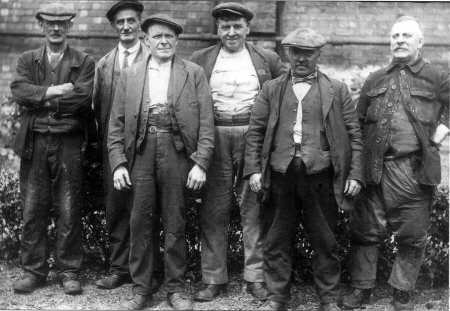
Above: A group of coal miners from Low Laithes Colliery, Gawthorpe in about 1922. The expressions on their faces suggest a lifetime of hard work. Does anybody recognise any of them to put names to faces?
Low Laithes Colliery closed down in 1927 as a direct result of the 1920s Depression. Trading was difficult with a reduced demand for coal and many coal miners were either on shortened working weeks or had already been made redundant. The 'Ossett Observer' in December 1928 noted that the chances of the Gawthorpe pit re-opening were remote and in fact it never did, despite probably being viable.

Above: The site of new Low Laithes colliery in Gawthorpe in 2007. The area has mainly been wooded over or returned to agriculture and there is little left to describe the industry that existed here.
In the event, the site changed its production role, re-emerging as the Doric Kerb Works, making concrete kerb stones for road construction. It is likely that the Doric Kerb Works was owned by the Low Laithes Colliery Co., Ltd. since in 1923 an H. Peace, an employee of the Low Laithes colliery company, patented a unique mould for the production of concrete kerb stones.
The Doric Works were derelict in the 1960s and it is believed that production ceased in the 1950s. There is now little evidence of this once thriving local industry and much of the area that was new Low Laithes colliery, then later the Doric Kerb Works, has now been returned to nature in the shape of a burgeoning woodland area and also to agriculture. The spoil heaps are long since gone and the pit shafts have been filled in. The only relic of the intense industry at Low Laithes Colliery and the Doric Works is a long, shallow triangular dam, which still survives.

Above: The only remaining relic of New Low Laithes Colliery and the Doric Kerb Works is this long, triangular dam, which is hidden in trees and brambles. When I took this picture in September 2007, a heron flew lazily off to the right when I disturbed him as he searched for fish in the old shallow, weed-infested dam.
Gawthorpe Churches
A growth of population in Gawthorpe led to the creation in 1901 of a third parish in Ossett (although it was technically designated a consolidated chapelry) bearing the name Gawthorpe with Chickenley Heath, combining portions taken from the older parishes of Ossett, Earlsheaton and Hanging Heaton. The church of Gawthorpe St Mary the Virgin was built in 1899 to serve the new parish.
St. Mary's Church, Gawthorpe closed in 2001 because of a declining congregation caused by road building and recent housing developments. The Gawthorpe parishioners were transferred to Holy Trinity Church, Ossett whilst Chickenley parishioners were transferred to a new church in Dewsbury. In 2007 planning permission was granted to convert the old church into a modern apartment block.
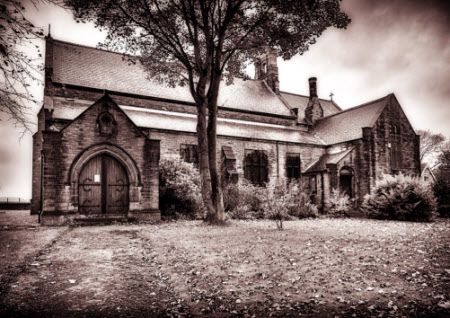
Above: St. Mary's Church, Gawthorpe circa 1935.
The Zion Congregational Church, Gawthorpe was opened in 1858 and closed in 1972 due to the general decline of religious interest during the 20th century. The building is now used as the Gawthorpe Darby and Joan Centre. The Gawthorpe Darby and Joan Club was formed in January 1950 by the late Mrs. F.G. Rhodes to provide extra amenities for the old folk of the village.

Above: The old Gawthorpe Zion Church, now the Derby and Joan Club.
The foundation stone of the Zion Church was laid in May 1858 by Mr Joseph Vero, and in seven months the building was complete. The door was at the other end on Zion Street, there was a gallery and the ceiling was lower than now. The inner walls were whitewashed and artificial lighting was by oil lamps. The building cost £650, a large sum for the congregation at that time (about £90,000 in 2022). The debt was not paid off until 1869. There is a datestone shown on the picture above which reads simply "Zion Church 1858". The opening services (afternoon and evening, with a tea in between) were on Wednesday, 8th December 1858.
The organisaton of the church was completed in 1859 and the first minutes of a church meeting are dated 1st September 1859. The first deacons of the church were elected on the 1st October, by name: Joseph Senior, George Lister and Benjamin Day. Throughout this time the effective leader of the church was T.H. Watson of Dewsbury, later of Soothill Hall. Sunday by Sunday, he either preached or provided a preacher.
The first minister, the Rev. William Dixon, took up his ministry on the 1st July 1864. He was well liked, and and within a year 49 additional sittings were let, so that in April 1865, it was reported that "there remain only 7 sittings unlet in the whole chapel, and these are in the most inconvenient positions for seeing and hearing the preacher."
Sadly, the Rev. Dixon fell ill; he resigned his charge in April 1866, and died the following year.
The current manse on the junction of Cross Street and Zion Street was built circa 1927. However an earlier manse had been built in 1873 and was designed by Owen Edwards from Manchester who also designed the Sunday School building.
The following from the "British Architect", 29/1/1875, Page 66 and "Building News", 3/10/1873, Page 381: "The committee were fortunate in purchasing a good-sized plot of ground and have erected a house for their minister, the Rev. William Daniell; the house contains drawing room, study, kitchen, etc. on the ground floor, which is cellared throughout, and three bedrooms are provided on the first floor."
The Rev. William Daniell succeeded the Rev William Dixon in July 1866 until 1878 when he was succeeded by the Rev. T.H. Heap from 1878 - 1887. The chapel was registered as a place of worship in 1867 and the first marriage was solemnized on the 16th March 1867 between Simon Casson and Elizabeth Audsley. In 1880, by virtue of the new Burials Act, Mr Heap conducted the funeral of Martha Butterfield, a member of Zion, in the graveyard of Hanging Heaton Parish Church - the first Non-Conformist service to be held in an Anglican graveyard in the district.

Above: Map from 1895 showing the position of Chapel and Sunday School. The manse was built adjacent to the Sunday School and both were demolished some time after 1970 and a bungalow known as 10, Zion Street was then built on the site.

Above: In the foreground is the new manse built circa 1927 and at the rear of the picture is the Zion Chapel and now Derby and Joan Club. The Yorkshire Congregational Union and Home Missionary Society (Incorporated) sold 306 square yards of land and the Chapel for a sum of £950 to the trustees of the Derby and Joan Club who were:
- Henry Nettleton, High Street,, Gawthorpe
- Eric Westmorland, The Beehive Inn, Gawthorpe
- Geoffrey N. White, Tree Tops, Swithenbank Avenue, Gawthorpe
- Jack Preston, Aicea Bungalow, Leeds Road, Ossett
There was a caveat in the sale to maintain a Right of Way from Zion Street to allow access with or without vehicles to the rear of the Zion Congregational Sunday School.
I am indebted to Peter Rockcliffe, the present owner of the Manse for his detailed research on the Zion Chapel, Sunday School and Manse whom has provided the majority of the historical information above.
The Salvation Army is now the only Christian church with its building in Gawthorpe. It was formerly a Wesleyan Chapel in the 19th century. The Salvation Army building serves as a community centre for the local community and provides dinners for senior citizens and facilities for parent and toddler groups.
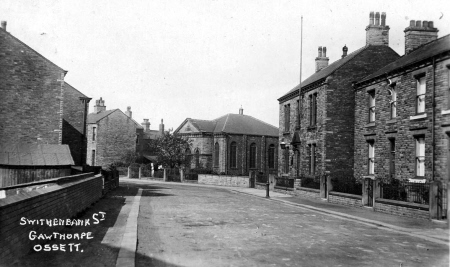
Above: A rare picture of Swithenbank Street, Gawthorpe (courtesy of Neville Ashby) taken from a postcard with a 1921 postmark. The building in the centre background is the Gawthorpe Bethesda Chapel, which was demolished circa 1956 and has now been replaced by housing. The building immediately to the right of the chapel with the flagpole is believed to be Gawthorpe Conservative Club or alternatively the Labour Club.
The Bethesda Methodist Chapel and Schoolhouse was opened in 1873 and came under the Dewsbury Circuit and the chapel is not mentioned in any Ossett Methodist records. The Sunday School served children in the village of Gawthorpe during the 19th century. Often, the only rudimentary education that the poorer children received was at Sunday Schools such as this, where, if they were lucky, they learned to read and write. The schoolhouse was demolished in the 1965 to make way for a modern bungalow, which now occupies the site.

Above: The Bethesda Chapel Schoolhouse, Gawthorpe pictured in 1962. It is believed that the buildings were demolished in 1965. The Bethesda Chapel was on the other side of High Street roughly where the Croft House Nursing Home is now located. The Bethesda Chapel was demolished for housing in the mid 1950s. The lane at the left of the old Bethesda Schoolhouse used to be known as Pepper Alley, but was later renamed School Lane. Pepper Alley was a desperately overcrowded area of Gawthorpe in the 19th century with a lot of old slum properties and in 1937, eleven of these old buildings were demolished after a meeting of the Sanitary Committee of Ossett Town Council. School Lane was later re-developed with more modern houses in the 1960s.
The Zion Congregational Church Burial Ground, Gawthorpe
At the start of the 20th Century, there were six places of worship within a half-mile radius of Gawthorpe village. Besides the well-established Gawthorpe Zion Congregational Church, which was the oldest, having been established in 1857, there were five others. The largest was the new Anglican Church of St. Mary the Virgin of Gawthorpe & Chickenley Heath, which was established in 1899. The new Wesleyan Methodist Chapel close to the junction of Dewsbury Road and Leeds Road (Leeds Road End) had been opened in 1884. Almost opposite the Wesleyan Chapel, nestled between Naylor Street and Stithy Street on Dewsbury Road was the Primitive Methodist Chapel. The old Wesleyan Methodist Chapel on Leeds Road between Royds Lane and Pickering Lane was still there, although this later converted to a Salvation Army citadel. In village of Gawthorpe, the Methodist New Connexion Church, Bethesda had been opened in January 1884.
At this time, there was very little empathy between the established Anglican Church and the varying flavours of non-conformity, which were increasingly popular in the 19th Century, perhaps partly because the non-conformist churches didn't operate the inequitable tithe system, which meant that Anglican parishioners were strongly encouraged to donate some of their income to the Church. The Commutation of the Tithe Act, 1836, established fixed money payments instead of the annual contribution of a tenth fraction of crops and livestock. Additionally, non-conformists, i.e. Methodists, Baptists, Congregationalists, etc. could not be buried in the consecrated ground of the Anglican Church. This was a problem, since Gawthorpe's Congregational and Methodist parishioners who had passed away, had to be buried at non-consecrated areas of graveyards, usually some distance from the village.
The Reverend Joseph Booth (1847-1939), who became Pastor of Gawthorpe Zion Church in 1897 decided that the good people of Gawthorpe should have a last resting place within the village. The origins of Gawthorpe Burial Ground are actually recorded in the pastor's own words within the Memoranda Book of the Zion Chapel:
"October 17th 1903. It was in the month of June 1902 that the Pastor suggested to Mr. B. Howroyd, a Member of the Congregation that he should provide a Burial Ground to the Zion. The suggestion was favourably received by Mr. Howroyd and after a fortnight's consideration, he decided to give a field known as Pond Croft to the Church. The necessary formalities required by the law were complied with and the sanction of the Local Government Board was obtained, and the ground was duly conveyed to the Trustees of Zion Congregational Church, Gawthorpe, Ossett, for the purposes of a Burial Ground, and was publicly dedicated for such purpose on Saturday, October 17th 1903.
Mr. Howroyd subsequently fenced the whole of the Burial Ground with an excellent stone and brick wall at his own cost. The first internment took place on February 23rd 1904. Owing to the objection of Mr. Harry Nettleton, the use of that portion of the ground, which lies within one hundred (100) yards of his property (i.e. the house near the gates of the Burial Ground) is forbidden.
A clause in the Deed of Gift provides that any person living in the North Ward of the Borough of Ossett up to the time of his decease, the relatives or the friends of such persons have the right to inter such persons in the said Burial Ground subject nevertheless to the Rules and Bye Laws and Scale of Charges in force at the time being, by order of the Deacons of Zion Congregational Church, and under the sanctions and authority of the said Church for the time being.
Since the Deed of Gift was made by Mr. Howroyd, he has expressed to the writer (Joseph Booth, Pastor) his regret that he did not stipulate that the net proceeds arising from the sale of graves and other dues should go towards the salary of the Minister for the time being. To the best of my knowledge and belief. Mr George Scholey, Deacon and Church Treasurer was present at the time Mr. Nettleton made the foregoing statement. J.B.
It was decided in February 1904 that the Ground should be designated The Zion Congregational Church Burial Ground, Gawthorpe, Ossett."
The Trustees of the new Burial Ground were mostly Deacons of the Zion Congregational Church, including Mr. Benjamin Howroyd (1834-1914), Fruit and Potato Merchant of Gawthorpe, who donated Pond Croft, which extended to some 2 acres 3 roods and 32 perches. The other Trustees were as follows:
- Mr. Allan Parkinson(1849-1919) was an Overlooker in a Woollen Mill and lived in Royds Lane, Gawthorpe.
- Mr. George Scholey (1857-1929) was a Carpet Weaver and lived in High Street, Gawthorpe (not buried at Gawthorpe).
- Mr. Smith Taylor (1863-1935) was first a Coal Miner and then a Grocer and Provision Dealer in High Street, Gawthorpe.
- Mr. William Henry Hallas (1852-1933) was an Overlooker in a Woollen Mill and lived in Cross Street, Gawthorpe.
- Mr. Ernest Atkinson Booth (1877-1947) was the son of the Pastor Joseph Booth and was a School Master living in Gawthorpe.
- Mr. Halliday Day (1870-1937) was a Fruiterer and Grocer with premises in High Street, Gawthorpe.
- Mr. Walter Day (1867-1945) was a Corn Teamer and lived in High Street, Gawthorpe
- Mr. George William Ellis (1853-1941) was a Rag and Mungo Carrier living in Royds Lane, Gawthorpe.
- Mr. Joseph Wilson (1870-1953) was a Butcher and later a Confectioner living in High Street, Gawthorpe
- Mr. Wilfred Gledhill (1865-1935) ran a Painting and Decorating business and lived in Dewsbury Road, Ossett.
- Mr. Smith Gomersall (1858-19??) was a Woollen Weaver and lived in Glenholme Terrace, Gawthorpe.
- Mr. James Edward Halstead (1868-1926) was a Machine Maker in the family business and lived in Royds Villas, Gawthorpe.
- Mr. Hinchcliffe Sharpe (1869-1946) was from a farming family but later he had his own Bakery business in Gawthorpe.
These gentlemen represented a cross-section of the various classes of people in Gawthorpe village and the immediate area where they all lived.
The first interment in the new graveyard was on the 23rd February 1904, about five months after the Burial Ground was dedicated on the 17th October 1903. This was the burial of Benjamin Howroyd's 21 year-old niece, Frances Riley who lived on High Street in Gawthorpe. Benjamin Howroyd himself was buried in Plot 1, Section F on the 25th July 1914. Howroyd had bought Plots 1, 2 and 3 with his niece laid to rest in Plot 3, but Plot 2 was never used.
There are about 250 original graves in the Gawthorpe Burial Ground, but some have multiple occupants. Apart from three or four, all the graves are in Section F. However, another 160 sets of human remains from 69 graves were exhumed from the Radley Street Burial Ground of the Ossett Congregational Church as part of the Dimple Wells slum clearance scheme in approximately 1969. The exhumed graves at Dimple Wells were established between 1811 and 1896, with the majority between 1820 and 1870 and included some well-known Ossett people, including Hannah Pickard and her brothers as well as Archer, Briggs, Brook, Ellis, Giggal, Mitchell, Oakes, Saxton, Scott, Wilby and my own Wilson ancestors. The apparently well-preserved remains were exhumed by a JCB, transported in an open-topped lorry and then then reburied in the Gawthorpe Burial Ground in a large pit, 9-10ft deep, allegedly just to the left of the main Burial Ground entrance, near to the west wall. No burial service or religious ceremony was performed when the bodies were re-interred and inexplicably, there is no record of the exhumation or subsequent re-interment in the ' Ossett Observer' or in the records of the two Congregational Churches concerned. What is certain is that the land at Dimple Wells was re-developed for new housing in the early 1970s.
The last burial at the Gawthorpe Burial Ground took place on the 30th October 1968 and was that of Michael Gummerson, 42 Swithenbank Avenue, Gawthorpe, son of Joseph Ward Gummerson, who was aged just 7 years when he died in a tragic drowning accident at Dewsbury Swimming Baths. He is buried in Plot 100 with his uncle, George Andrew Gummerson who had died in 1948 aged 43. The plot for the grave had been bought by Mrs. Violet Gummerson of 15, Bridal Lane, Gawthorpe on the 14th December 1948.
Gawthorpe Schools
Gawthorpe Junior and Infants School was opened in 1927, but prior to that, National School in Gawthorpe was further down Royds Lane at the junction with Leeds Road. This school was constructed in 1840, but was demolished in the 1970s to make way for the new Ossett bypass.

Above: St. Mary's Church School Hall, previously called the National School at the junction of Royds Lane and Leeds Road in Gawthorpe pictured about 1970, just before demolition for the Ossett Bypass.

Above: The Gawthorpe Zion School, Zion Street. The school was built after children meeting on Sundays in a room below the Zion Chapel became so numerous that more space was needed. Land adjoining the chapel was bought and a new Sunday School and Manse (which can just be seen to the extreme left of the picture above) were built. Mark (later Sir Mark) Oldroyd laid the foundation stone and the new school was opened in September 1873 at a cost of £1,250 ( about £150,000 in 2022), which was paid off by 1880. The West Riding Congregational Chapel Fund made a grant of £200 and a bazaar to raise money was held in the Ebenezer Sunday School in Dewsbury.
The Rev. Joseph Booth (1847-1939) became the minister of the Zion Church form 1897 to 1910 and in 1899 he became the Hon. Sec. of the Ossett Association of Undenominational Day Schools, which was responsible for two new Day Schools at South Ossett and Flushdyke. These non-conformist schools were an important part of the education sector at the turn of the 20th century, providing education for many working class children who otherwise would have no education opportunities.
However, with the passing of the Balfour Education Act of 1902, the Ossett Association of Undenominational Day Schools was disbanded. Opposition to the Act came especially from Methodists, Baptists and other non-conformists like Congregationalists. They were outraged at the support for Anglican and Catholic schools and angry at losing their powerful role on elected school boards.
The Act put an end to broad-based expansion of secondary education that had originated in so-called higher grade schools established by progressive, popularly elected local boards. Instead, secondary education was to be administered by county council committees in specifically designated secondary schools, admission to which was strictly controlled to exclude all but a very few working class children.
This important issue was a matter of major concern to working class reformers anxious to provide a democratic highway rather than an exclusionary ladder to secondary education. The Liberal Party led the opposition and made it a major issue especially in the General Election of 1906 in which the Liberals defeated Balfour's Conservative Government in a landslide victory.
Non-conformist opposition was championed by John Clifford, the Baptist Pastor of Westbourne Park Church in London who became the recognised leader of the Passive Resistance to the education act. Clifford formed the National Passive Resistance Committee, which hoped convince more non-conformists to resist the act and stop paying their rates until it was repealed. By 1904, over 37,000 summonses for unpaid school taxes were issued, with thousands having their property seized and 80 protestors going to prison. Some of Ossett's non-conformists joined the Passive Resistance Movement.
Gawthorpe's Textile Mills
Royds Mill, previously known as Fosters Mill on Leeds Road was often described as a 'the cotton mill' since, when it had opened in 1820, it had been used for cotton spinning and weaving, which was unusual for Ossett. The mill was still called Fosters Mill in 1854 as shown on the OS Map below. Later, the mill was owned by John Lee and Sons, who were blanket manufacturers and by 1879, when their business failed, the mill was bought by George Hanson (1837-1893) and Henry Wormald, two local men from Gawthorpe. At some time after 1854, the name of the mill was changed to Royds Mill. However, it is known that some of George Hanson's ancestors had owned the mill a generation or two previously. Hanson and Wormald had started their partnership in March, 1875 as rag and mungo merchants, first renting rag-pulling machinery at Greengates Mill, Chickenley Heath and then moving to Greaves Mill at Gawthorpe.
George Hanson was the senior partner with Henry Wormald in their business concern at Royds Mill, which they operated as woollen rag and mungo merchants, buying in huge stocks of rags. In 1881, they employed 25 men and 90 women in the mill, letting part of their extensive premises to other manufacturers. Royds Mill itself had been extended several times from a single mill building running parallel with Leeds Road before it was bought by Hanson and Wormald. By 1881, there were three large mill buildings; two were four-storeys high and one was three-storeys high with additional offices, stables, dye-house and an engine house complete with a 300 horse-power, steam-powered, condensing beam engine and two Cornish boilers with a dry- house over the top of them.
In 1887, the business was doing well and George Hanson had recently built a large detached house in extensive grounds, just off Royds Lane, called "The Mount". The new house was built on one of the highest points in Gawthorpe with extensive all-round views. Hanson's partner, Henry Wormald, lived with his wife Sarah in the more modest, but decidedly up-market, Royds Villas, just past the mill on Royds Lane.
Disaster struck on September 6th 1887 when fire broke out during the night in a rag warehouse at the mill. This was at a time when they had a higher stock of rags than ever before, having availed themselves of recent price fluctuations in the market to buy heavily. The bales of rags were piled up from floor to ceiling on the first and second floors in two of the large mill buildings and in all there were hundreds of tons of rags in the mill buildings.
Sadly, because of the prevailing drought in the summer of 1887, the water supply to Gawthorpe was turned off overnight. For over an hour, there was no water for the high-pressure hose pipes and the fire very quickly took hold, completely destroying Royds Mill. It was said at the time to have been the most extensive and rapidly destructive fire ever to have taken place in Ossett within living memory. The fire caused £30,000 of damage if the losses of the other occupants of Royds Mill; Mr Joseph Briggs and Messrs. Briggs and Waterhouse, cloth manufacturers were taken into account.
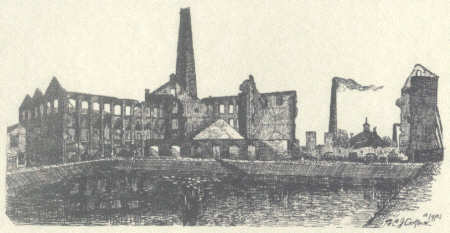
Above: A drawing from Cockburn's "Ossett Almanac" depicting Royds Mill after the fire which destroyed the buildings in September 1887. The other mill chimney, which is smoking is at nearby Greaves Mill (see map below.)
About 170 workers were made redundant overnight because of the fire. Part of the gutted building fell into Leeds Road causing it to be closed to traffic and the embers of the building burned for days. However, almost immediately, Hanson and Wormald resumed operations at nearby Greaves Mill, which had been unoccupied for some time. They also subsequently rebuilt Royds Mill with one storey sheds replacing the previous four-storey buildings, despite only being insured for about half of their considerable £26,000 loss as a result of the fire.
Both George Hanson and Henry Wormald were involved in public life and became Mayors of Ossett. Sadly, George Hanson died at the early age of 55 from a bout of pneumonia during his term of office as Ossett's mayor. He was staying at Southport over the Easter holiday in 1893 in an attempt to recuperate from his illness when he succumbed and died. Hanson, a lifelong teetotaller and stalwart of the Zion Congregational Church in Gawthorpe, was also an ex-Chairman of Ossett's Local Board, and was a very popular and well-liked man. He was afforded a public funeral at Holy Trinity Church, Ossett where he was buried with many tributes to his contribution to public life. The "Ossett Observer" said of him in 1889 " Of him it may be said that Gawthorpe never furnished a member more attentive to its particular interests, or one who took a wider and more intelligent view of local matters generally."
Henry Wormald J.P. (1837-1901) lost his wife Sarah Ann in October 1891 and sadly the couple had no children, so, after the death of George Hanson in 1893, Wormald enthusiastically put his heart and soul into running the business at Royds Mill and he also decided to take part in public life by getting involved with local politics. In 1900, he converted the mungo and rag business at Royds Mill into a (private) limited liability company.
A native of Gawthorpe, as a young man, Henry Wormald was a piecener at Royds Mill, when it was a blanket factory and he was subsequently employed in the mungo trade in Ossett and Morley before going into partnership with Hanson. Wormald succeeded George Hanson as councillor for the North Ward in Ossett, being re-elected several times without opposition. He became mayor of Ossett in 1899 and had a reputation for working hard on behalf of the Borough and for his native Gawthorpe. A staunch Congregationalist at the Zion Church in Gawthorpe, Wormald was also president of the North Ward Liberal Club. Wormald had been ill for some time and died on the 16th July 1901. He was buried in the family vault at Holy Trinity Church, Ossett with his wife.
Greaves Mill
Greaves Mill was built about in about 1840 by the Greaves family who had extensive business interests in Ossett, owning Greaves Mill in Gawthorpe plus warehouses, a counting house and cottages. Three brothers Joseph, Joshua and Thomas Greaves built and ran the woollen mill, which can be seen on the map below. Joseph Greaves, who was born circa 1800 was the eldest of the three and he passed on the mill and other family businesses to his sons George and Henry.
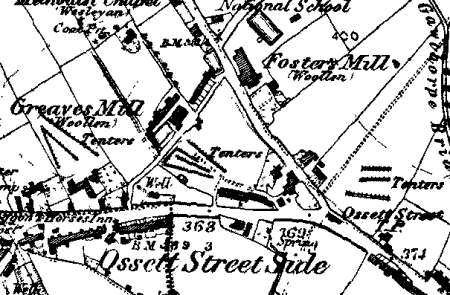
Above: 1851 OS Map showing Greaves Mill and Fosters Mill when it was a four-storey building (later Royds Mill) and St. Mary's Church School Hall called at that time the National School.
By 1881, this next generation of Greaves brothers; George born in 1823 and Henry born in 1827, who were also farmers, were now running the family business at Greaves Mill. Greaves Colliery, between Streetside and Bridle Lane, Gawthorpe was owned between 1855 and 1860 by Joshua Greaves of the same family and one of the brothers from an earlier generation.
George Greaves, built Heath House in 1854 for his new bride, 15 year-old Ann Heaton. The house, which sits in nearly five acres of land, was built immediately adjacent to the mill. Henry Greaves, who never married, lived at Greaves House (later renamed Quarry House), also very close to the mill. It appears that by about 1885, the business had failed because Greaves Mill was unoccupied. In 1892, George Hanson purchased Greaves Mills, which had been standing empty for several years. They were renamed as Borough Mills and it was Hanson's intention that the mill would provide additional employment for people living in Gawthorpe.
At the time of George Greaves' death in 1899, he was living at Lodge Hill Farm, Gawthorpe. His brother Henry Greaves died in 1895 and was living at New Park Farm, Gawthorpe.
The old site of Greaves Mill and Greaves House is now the location of a large traffic island at the Gawthorpe end of the Ossett Bypass. Heath House, just off this roundabout has thankfully survived and is now a four-star rated hotel run by Jo Holland, whose family have owned the house for over 50 years.
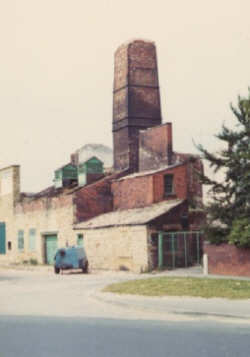
Above: Royds Mill pictured in decline circa 1977. It was later adapted for factory units with the Wakefield Car Warehouse, Dulevo (a cleaning company) and Diespeker GRP Products all now taking up residence in the old mill sheds.
Gawthorpe's Public Houses
In the 19th century, there is some evidence of the existence of at least two beerhouses in the village, where beer was brewed and could be bought and drunk on the premises. Beerhouses were usually private houses with one or two rooms converted into public rooms. This followed the controversial Duke of Wellington's Beerhouse Act of 1830. The Act, designed to curb the rise of gin consumption and to bypass local magistrates legislation, allowed any householder or ratepayer, on payment of two guineas to the Excise, to sell beer and cider (but not wine or spirits) from their property. The Act was pushed through by Arthur Wellesley, Duke of Wellington, before he was ousted from Downing Street. It was in response to increased agitation over the 200 year-old licensing laws which were regarded as archaic.
For many years, Gawthorpe boasted three public houses: the Boot and Shoe, the Beehive and the Shoulder of Mutton Inn. However, the Shoulder of Mutton is by far the oldest licensed pub in the village and dates back to before 1822, when the landlord was Percival Terry. The Shoulder of Mutton was classed as an inn, so patrons could sleep, as well as eat and drink. Most publicans strived to gain inn status since this allowed them to remain open as long as a bed was empty and food was offered to any lawful visitor or traveller. They could also serve any kind of alcoholic drink and were not restricted to selling just beer or cider. However, the established inns faced increasing competition from the large number of beerhouses springing up after 1830 and this would have been the case in Gawthorpe.
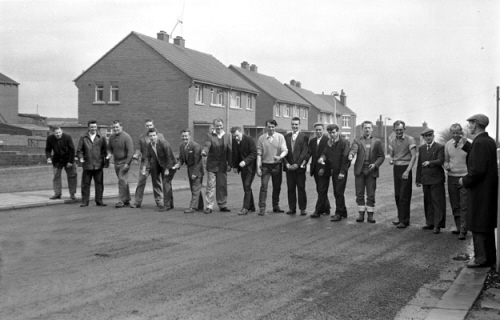
Above: The start of the Easter Monday 1963 Gawthorpe Egg and Spoon race, which preceded the Gawthorpe Coal Carrying Race. Teams were from the Beehive, Boot and Shoe, Shoulder of Mutton and Belmont Working Men's Club (See RH sidebar for more information.) My thanks to Roy Smith, a Gawthorpe man now living in Canada for the picture and for the following names of the contestants: From L: to R: 1. Bunny Oldroyd 2. Barry Wimpenny 3. Roy Smith 7. Walter Leather Deceased 13. Raymond [Giz] Gardner and extreme right Fred Hirst. Does anyone recognise any of the others in this group?

Above: The Boot and Shoe, Gawthorpe circa 1900.
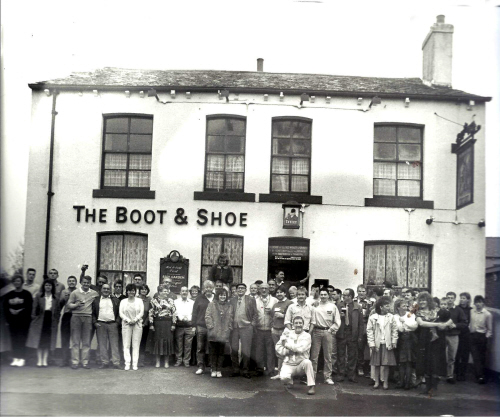
Above: The Boot and Shoe, Gawthorpe in 1991 with some of the patrons.
The Boot and Shoe was classed as a beerhouse until 1961, when landlady Kate Edith Mugglestone successfully applied for an All Liquors Licence, but it dates back to 1866 when John Ingham was the licensee. The Beehive was classed as a beerhouse in 1838 and, at the time, was run by Ann Jessop. By 1857, the licensee and publican of the Beehive was Randolph Jessop, who was also a cloth weaver. By 1872, the Beehive had been licensed under the 1828 Licensing Act and so was no longer classed as a beerhouse and could sell spirits as well.
In Gawthorpe, there was a Liberal Club and also a Conservative Club in Bridle Lane, which was demolished at the time of the building of the Ossett bypass. The Belmont Working Men's Club, (which may have earlier been the Liberal Club), became the present Conservative Club, in April 1971, which is licensed to sell beer and spirits.
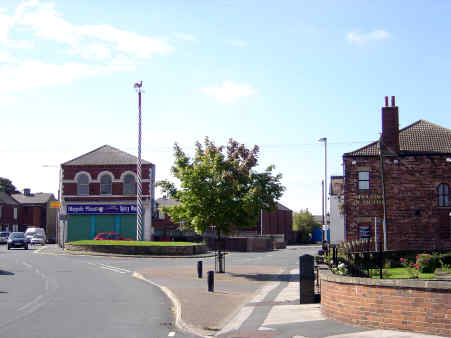
Above: The Maypole in September 2007. To the right of the Maypole is the Shoulder of Mutton public house and the building behind the Maypole is the old Gawthorpe Co-op, now a pizza parlour with an Eastern flavour.
In 2006, the Beehive Inn was demolished by its owners Leisure Inn Developments Ltd to make way for the construction of new housing on the old site. Despite a spirited campaign for English Heritage listed status by local residents, CAMRA and others who wanted to preserve the historic, over 100 year-old, public house, the bulldozers raised the pub to the ground in November 2006. All that remains currently in 2007 is a pile of rubble and to date, no houses have been built on the site.
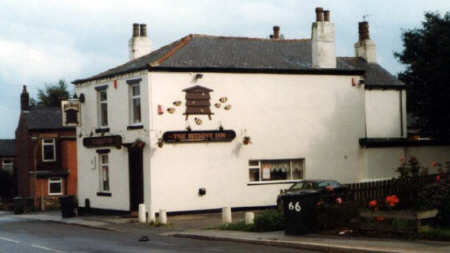
Above: The Beehive, Gawthorpe, which was demolished in 2006 after declining trade and the high costs of repair forced the owners to sell the site for housing.
The Gawthorpe Bould Family
My wife's grandfather, David Bould (1872 - 1938) was from a long-established Gawthorpe family, dating back at least to the early 1700s. David's grandparents, Joseph and Mary Bould were tenant farmers with premises down Gawthorpe Lane, close to the new Low Laithes Colliery. David's father, Mark Bould (1838-1898) also worked on the family farm and the children were brought up there. David Bould was an excellent horseman and became a groom for Henry Wormald, co-owner of Royds Mill and one-time Mayor of Ossett.

Above: David Bould, one of the long-established Gawthorpe Bould family, pictured in about 1900.
Sportsman’s Death - David Bould's Obituary 1938 1
Mr David Bould of 4 Bridle Lane, Gawthorpe who died on Sunday after a long illness at the age of 65 was a well-known local sportsman. In his younger days he played with the old Ossett Rugby Club and subsequently with Gawthorpe Football Club. He was a prominent playing member of Ossett Flying Horse Bowling Club for over 20 years up to the time of his death and was also fond of horseback riding. A native of the village where he had resided all of his life, Mr Bould was a groom during his boyhood and early adulthood for the late Mr Henry Wormald who was the Mayor of Ossett from 1899-1900. After carrying on business as a farmer for several years, he afterwards acted as a carting agent for his cousin Mr Turton Bould. Eight years ago he was knocked down by a motorcar near the Flying Horse Inn and sustained injuries to his chest, a broken collarbone and broken wrist. The funeral took place on Wednesday at Ossett Parish Church, the vicar the Rev. G.H. Marshall officiating. Mr Bould leaves a widow, a son and two daughters.
References:
1. "Ossett Observer", Saturday, 12th November 1938.
2. "Leeds Mercury", Thursday, 25th September 1890.
3. "Bradford Observer", Monday, 7th September 1874.
4. "Bradford Observer", Tuesday, 15th September 1874.
5. "Bradford Observer", Friday, 25th September 1874.
6. "Bradford Observer", Tuesday October 13th 1874.
7. "York Herald", Monday, January 11th 1875.
Ossett History
- In Utile ex Arte
- Oslaset - Origins
- Domesday & Beyond
- 14th & 15th Centuries
- 16th & 17th Centuries
- 18th Century
- 19th Century
- 20th Century
Ossett Heritage
- Ossett People
- Ossett Academy
- Ossett Spa
- Ossett Water
- Ossett Collieries
- Ossett Houses
- Ossett Mills
- Gawthorpe
- Healey & Millbank
- Low Laithes
- Mark Senior
- Eli Marsden Wilson
- Flushdyke Sketches
- Brammer's Ossett Sketches
- Ossett Virtual Blue Plaque Scheme
Kids Corner
Green Park 
Links
Gawthorpe Water Tower
One of Gawthorpe's best known landmarks is the water tower, which was built in the 1920s.

Gawthorpe Water Tower dominates the skyline and can be seen for miles around. It is located at the highest point of the Ossett-cum-Gawthorpe area, mid-way along Chidswell Lane in Gawthorpe. This huge concrete structure was constructed between 1925 and 1928 to store drinking water for the town, which was pumped from the Pildacre Water Works some 1.25 miles away. The 25-foot trough has a capacity of 200,000 gallons or nearly 1 million litres. The pinnacle of the tower is now also used to accommodate collinear mobile telephone aerials.
Work was started on the construction of the adjacent underground reservoir in May 1876 after much opposition from local Gawthorpe residents. The reservoir was opened in 1877 and although it was found that the three miles of ten-inch water pipe to Staincliffe was sound and water-tight, the reservoir leaked badly. The Local Board had let the construction of the reservoir to contractors, but after a few month's of work had been completed, the contractor was fired and the work completed by local 'direct labour'. Someone had maliciously placed two wooden planks in the puddle trench foundations, causing the reservoir to leak.
In the 1870s, when it was decided that sewers and running water would be introduced to Ossett-cum-Gawthorpe, the residents of Gawthorpe objected strongly to the increase in rates to pay for the new development. A group of angry Gawthorpe residents marched ‘en masse’ to Ossett, where a public meeting was being held to discuss the introduction of sewers and running water to the now rapidly expanding town. They succeeded in halting the meeting and marched triumphantly back to Gawthorpe with a brass band at the front of the procession. The Gawthorpe protest was in vain with the successful introduction of running water and a new sewerage system in Ossett shortly afterwards.
Gawthorpe Recreation Ground
In 1925, Capt. Guy Shafto Rowley made a gift of the land for the Gawthorpe Recreation Ground to the village. Located on Chidswell Lane (previously called Jack Lane), the new Recreation Ground was located immediately opposite the village football field, which was on the opposite side of Chidswell Lane.
Gawthorpe Burial Ground
In 1969 over one hundred bodies dating from the 19th century were exhumed from the old Ossett Congregational Chapel Burial Ground at Dimple Wells in Ossett after the land was sold for housing development. The bodies of these poor souls were then re-interred at the now largely forgotten Burial Ground in Gawthorpe. Access to the old Gawthorpe Burial Ground is now very difficult because of locked gates on the approach through Howroyd's Yard. Wakefield MDC seem unaware of the site's existence or historic significance.
Alarming Explosion at Ossett Colliery - 1895
A serious accident occurred in one of the coal seams worked by the Low Laithes Colliery Company Limited, at Gawthorpe, Ossett. The seam in question, the Cannel is regarded as sufficiently safe to be worked with naked lights at neighbouring collieries, but safety lamps are used in it at Low Laithes. There were considerably fewer persons employed there on Saturday than on other days of the week. Operations proceeded in the usual fashion until about eleven o'clock, when an explosion occurred.
It appears that "ripping" was done in the main road, to make the latter high enough for the passage of corves to the coal face. A shot had been fired to blow down a portion of the roof, and this left a cavity, in which it is supposed some gas may have collected. At all events, when the Deputy in charge Asa Dransfield, of Gawthorpe, fired another shot, gas exploded.
Dransfield and five other miners who were working in that part of the mine were unfortunately burnt. As soon as possible they were drawn to the surface. Dr. Mill (Messrs. Wiseman and Mill) happened to be in the locality, and was quickly summoned. The colliery surgeon, Mr. Oates, of Dewsbury arrived later. Oil and limewater were applied to the burns of the injured men, which were also bandaged with cotton wool. Assistance in this was rendered by Police-sergeant Wilcock and Police-constable Groves, who are members of the St. John Ambulance Association. Under the direction of Dr. Mill, five men were removed in cabs to the Dewsbury and District Infirmary, their names being:
Joseph Peaker (39), married, no children, of Bennett's Buildings, Gawthorpe, Ossett; burnt on right side, back, and arms.
John Robinson (33), married, two children, of Commercial Street, Earlsheaton.; burnt on back, shoulder, face, and arms.
Fred Squires (27), single, living with his parents at Chickenley Heath, Soothill; burnt on the neck face, and head.
Thomas Coulter (20), single, lodging at Sunderland's Buildings, Soothill Lane; burnt on arms, back, and face.
Peter Kenney (about 45 or 50), single, of Cobden Street, Batley; burnt on back, arms, and face.
Asa Dransfield, the deputy, who was badly burnt on his arms, etc. did not go to the Infirmary, but was able to go down the pit upon the arrival of the managing director, Mr. A.B. Blakeley of Dewsbury, and explain how the accident had occurred. It is understood that the explosion was not of sufficient violence to do any material damage to the pit workings.
Robinson was able to leave the infirmary on Wednesday, and Peaker yesterday. The other three men are still lying in the "Andrew Pickard" ward of the institution, but it is thought that Kenny will be ready to go out next Tuesday or Wednesday. Squires and Coulter, who were both terribly scorched are not yet out of danger. Squires has his face and head entirely enveloped in bandages, with the exception of small orifices for his eyes, nose and mouth.
From the "Ossett Observer" June 13th 1895
Gawthorpe Coal Carrying Race
Roy Smith, born and bred in Gawthorpe, but now residing in Canada, writes that the coal race was actually born after a 1963 Easter Monday Egg and Spoon race between the patrons of the Beehive, the Boot & Shoe, the Belmont Club and the Shoulder of Mutton pubs
What originally started the discussion about a competition was which pub had the best beer. The Beehive was Websters; the Boot and Shoe was Tetleys; the Belmont was Beverleys and the Shoulder of Mutton was Whitakers.
The bet was whichever pub team won the egg and spoon race, then the pub supplied a barrel of beer. Did not matter which team won we all got free beer for the day. The Beehive was the winning team in 1963.
Another account of how the Gawthorpe coal race started is as follows:
At the now demolished Beehive Inn, which was over a century old, and situated in High Street, Gawthorpe, the following incident took place one day circa 1963. Reggie Sedgewick and one Amos Clapham, a local coal merchant and a past-president of the Maypole Committee were enjoying some well-earned liquid refreshment whilst stood at the bar lost in their own thoughts. When in bursts one Lewis Hartley in a somewhat exuberant mood. On seeing the other two he said to Reggie, " Ba gum lad tha’ looks buggered!" slapping Reggie heartily on the back. Whether because of the force of the blow or because of the words that accompanied it, Reggie was just a little put out. " Ah’m as fit as thee" he told Lewis, " an’ if tha’ dun’t believe me gerra a bagga coil on thi back an ‘ah’ll get one on mine an ‘ah’ll race thee to t’ top o’ t’ wood!" (Coil, is Yorkshire speak for coal).
Whilst Lewis digested the implications of this challenge, a Mr. Fred Hirst, Secretary of the Gawthorpe Maypole Committee (and not a man to let a good idea go to waste) raised a cautioning hand. "Owd on a minute," said Fred, and there was something in his voice that made them all listen. "Aven’t we been looking fer summat to do on Easter Monday? If we’re gonna ‘ave a race let’s ‘ave it then. Let’s ‘ave a coil race from t' Barracks to t' Maypole." (The Barracks being the more common name given by the locals to The Royal Oak Public House on Owl Lane, Ossett)
Thus was born The World Coal Carrying Contest which every Easter Monday lifts the village of Gawthorpe out of obscurity and into the headlines. No event in the Olympic Games could stimulate more enthusiasm than this annual contest of stamina and muscle. The race itself is held over a distance of 1012 metres and, of course, involves carrying a standard hundredweight sack of coal (112 lbs or 50kg)
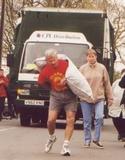
Not slow to latch on to a good idea, there is now a Scottish Coal Carrying Championship, held in the town of Kelty in Fife, which is now in its twelfth year. Held in June each year, the rules are very similar to the Gawthorpe event and the race is run over a distance of 1000 metres with 50kg sacks of coal for male competitors and 25kg for female competitors.
Goff White
G.N. White was known to generations of Gawthorpe people as 'Goff'. Godfrey Nettleton White was the son of Ossett fish merchant George White and was born in 1908. He married Edith Reddick on August Bank Holiday Monday, 1932. They were married at Gawthorpe St. Mary's by the Reverend Shelton. The marriage took place at 8 a.m. because Mr. and Mrs. Reddick, Edith's parents were moving house that day.

Godfrey and Edith were not only taking over the Reddick house next to the Zion Chapel, but were also to take over the Fish Shop on the following Tuesday.
For sixty years, Goff's was part of the village. The first fish shop was a wooden hut near to the corner of Swithenbank Street, facing on to High Street. For the first seven years of their partnership, Goff and Edith worked in this hut, their Fish Shop.
Goff, in his early years, was a choirboy at Holy Trinity Church. In the 1930s, he played in the Gawthorpe St. Mary's cricket team.
In 1939, Goff left the wooden hut for a bright new brick-built fish shop, which he had built across the road. He had hardly enough time to warm the pans, when he was called up to join the RAF. During these war years, Edith was responsible for running the Fish Shop, struggling against the shortage of supplies. With help, she was able to keep the business going.
Goff was the last of the village's old-time shop-keepers, who were part of the community. He was a trustee of the Darby and Joan Club, trustee of the Maypole Field, advertiser in the Maypole brochure every year, and a generous giver.
Village news circulated in his shop. If you wanted to know the latest on Yorkshire County Cricket or Dewsbury Rugby League Football Club, then it was available at Goff's.
The contemporaries of Goff worked and earned their living in the community and they gave so much back.
How they are sadly missed.
Adapted from the "118th Gawthorpe Maypole Feast and Procession Souvenir Brochure" dated 1992.
Death September 1968 – George Bould, 9 Cross Street, Gawthorpe
George Bould, firewood merchant and ice-cream vendor died aged 60 years. Mr. Bould travelled around with a donkey and cart selling ice cream and firewood. He was just 4ft 7” in height and was the smallest man in the Home Guard during WW2. He was married in 1952 to Minnie who worked in the bakery trade in Bradford. Two brothers survive him: Charles Bould who lives at Batley Carr and Clifford Bould, a well-known athlete now living in Australia. - Taken from the Ossett Observer archive 1968
1298 - Ossett
Robert Sonneman, Sosanna de Goukethorp, Adam de Goukethorp and Adam de Chykenley fined for breaking the pale, and fined 6d, 2d, 2d and 2d respectively.
1316 - Ossett
Adam, son of Richard de Gaukthorp gives 2o shillings as heriot of 26 acres 3 roods of land and meadow with buildings in Gaukthorp after the death of the aforesaid Richard his father to hold for himself and his heirs, doing the service therein etc, and the custody of the said Adam is delivered to his mother Agnes by reason of his minority, until he is of full age. He found as pledges to see the sufficient upkeep of the land and buildings, Adam de Gaukthorp and Robert Sonneman.
1316 - Ossett
William Carpenter of Gaukthorpe demands against Adam de Gaukthorpe and Robert Sonneman as executors of the testament of Richard de Gaukethorpe, 1 supertunic, 1 trinket, 1 bow and 24 arrows, 1 horn together with a knife, and 1 dagger as the legacy of the said Richard. The said Adam and Robert came and confessed that all these things were bequeathed to the said William as is pledged. Therefore it is decided that they make satisfaction to him and are amerced 12d.
Transcribed from the Wakefield Court Rolls